Balanced Scorecard Basics
What is a Balanced Scorecard?
- Communicate what they are trying to accomplish
- Align the day-to-day work that everyone is doing with strategy
- Prioritize projects, products, and services
- Measure and monitor progress towards strategic targets
The name “balanced scorecard” comes from the idea of looking at strategic measures in addition to traditional financial measures to get a more “balanced” view of performance. The concept of balanced scorecard has evolved beyond the simple use of perspectives and it is now a holistic system for managing strategy. A key benefit of using a disciplined framework is that it gives organizations a way to “connect the dots” between the various components of strategic planning and management, meaning that there will be a visible connection between the projects and programs that people are working on, the measurements being used to track success (KPIs), the strategic objectives the organization is trying to accomplish, and the mission, vision, and strategy of the organization.
Who Uses the Balanced Scorecard (BSC)?
BSCs are used extensively in business and industry, government, and nonprofit organizations worldwide. More than half of major companies in the US, Europe, and Asia are using the BSC, with use growing in those areas as well as in the Middle East and Africa. A recent global study by Bain & Co listed balanced scorecard fifth on its top ten most widely used management tools around the world. BSC has also been selected by the editors of Harvard Business Review as one of the most influential business ideas of the past 75 years.
What Are Balanced Scorecard Perspectives?
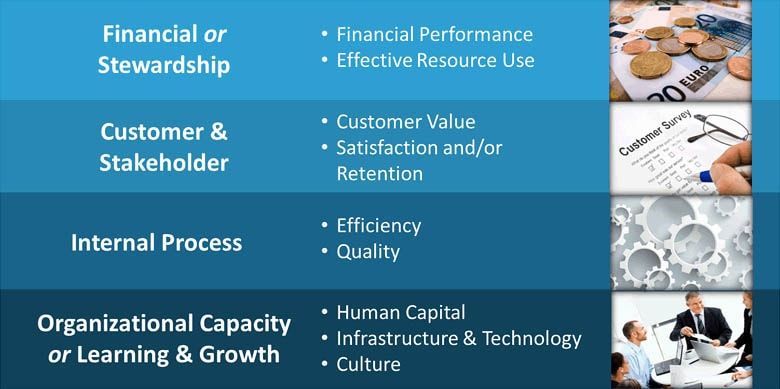
The BSC suggests that we examine an organization from four different perspectives to help develop objectives, measures (KPIs), targets, and initiatives relative to those views.
- Financial (or Stewardship): views an organization’s financial performance and the use of financial resources
- Customer/Stakeholder: views organizational performance from the perspective of the customer or key stakeholders the organization is designed to serve
- Internal Process: views the quality and efficiency of an organization’s performance related to the product, services, or other key business processes
- Organizational Capacity (or Learning & Growth): views human capital, infrastructure, technology, culture, and other capacities that are key to breakthrough performance
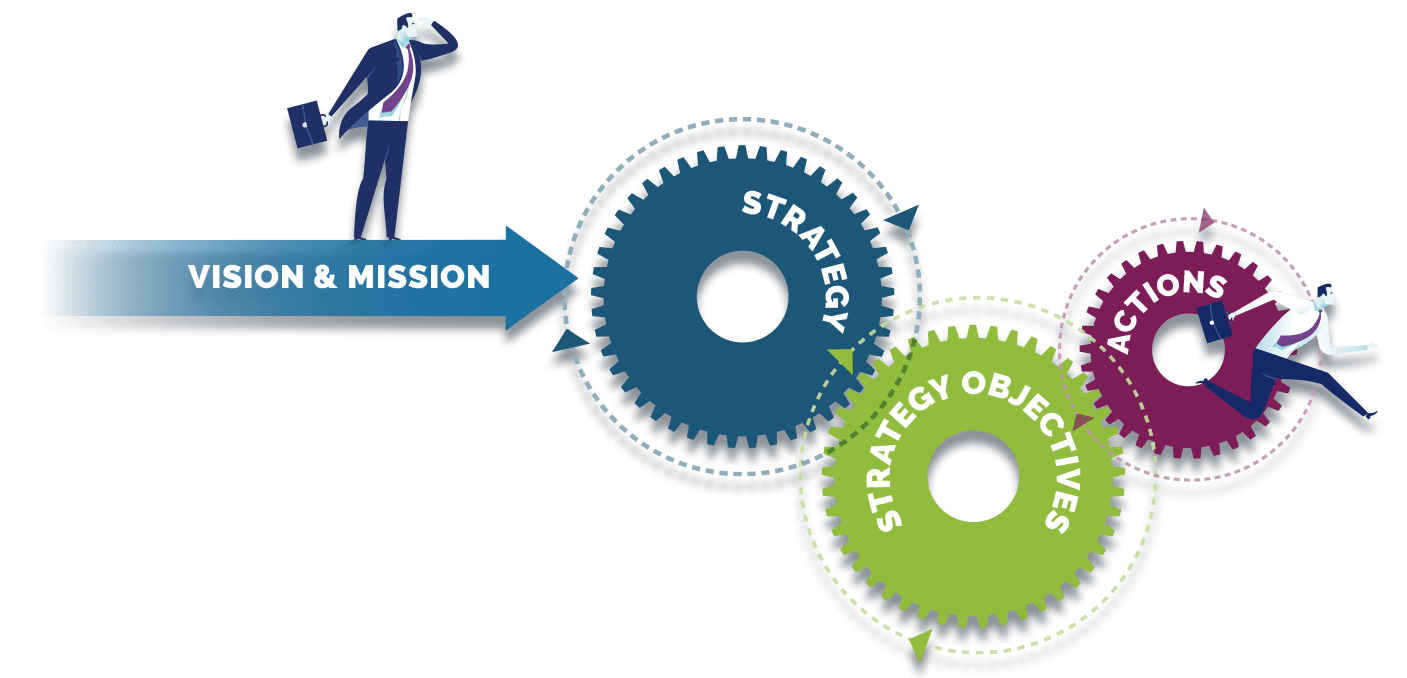
What Are Strategic Objectives?
Strategic Objectives are the actions we must implement into our daily activities in order to see improvement in our strategies. They break down abstract concepts like mission and vision into actionable steps.
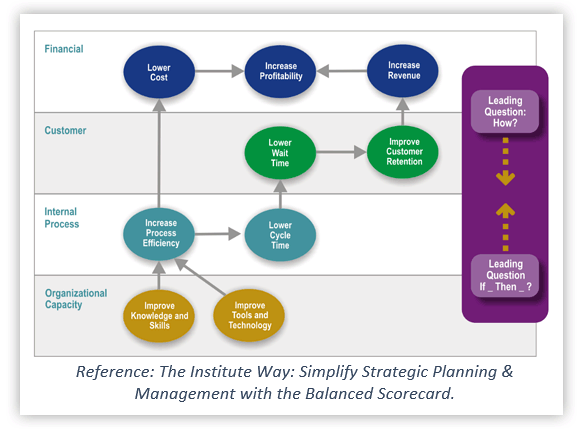
What Is a Strategy Map?
One of the most powerful elements in the BSC methodology is the use of strategy mapping to visualize and communicate how value is created by the organization. A strategy map is a simple graphic that shows a logical, cause-and-effect connection between strategic objectives (shown as ovals on the map).
What Are Performance Measures (KPIs)?
For each objective on the strategy map, at least one measure or Key Performance Indicator (KPI) will be identified and tracked over time. KPIs indicate progress toward a desirable outcome. Strategic KPIs monitor the implementation and effectiveness of an organization’s strategies, determine the gap between actual and targeted performance and determine organization effectiveness and operational efficiency.


What Are Strategic Initiatives?
Strategic Initiatives are projects (new or existing) that are designed to help the organization achieve Strategic Objectives and have significant organization-wide impact. They are managed formally like any other project, meaning they are explicitly defined in terms of owner, schedule, resources needed, action steps, progress, and expected results. Some Strategic Initiatives are short-term (taking only a few days to implement) while others can take years to fully implement. Strategic Project Management is the process of managing projects to achieve strategic success.
What is Cascading?
Cascading a balanced scorecard means to translate the corporate-wide scorecard (referred to as Tier 1) down to first business units, support units or departments (Tier 2) and then teams or individuals (Tier 3).
Cascading strategy focuses the entire organization on strategy and creating line-of-sight between the work people do and high level desired results. As the management system is cascaded down through the organization, objectives become more operational and tactical, as do the performance measures. Accountability follows the objectives and measures, as ownership is defined at each level. This alignment step is critical to becoming a strategy-focused organization.
BSC Automation and Performance Analysis
Once a scorecard has been developed and implemented, performance management software can be used to get the right performance information to the right people. Automation adds structure and discipline to implementing the Balanced Scorecard system, helps transform disparate corporate data into information and knowledge, and helps communicate performance information. The Balanced Scorecard Institute formally recommends the Spider Impact developed by Spider Strategies and co-marketed by the Institute.

Balanced Scorecard History
The Balanced Scorecard was originally developed by Dr. Robert Kaplan of Harvard University and Dr. David Norton as a framework for measuring organizational performance using a more balanced set of performance measures. Traditionally companies used only short-term financial performance as the measure of success. The “balanced scorecard” added additional non-financial strategic measures to the mix in order to better focus on long-term success. The system has evolved over the years and is now considered a fully integrated strategic management system.
This new approach to strategic management was first detailed in a series of articles and books by Drs. Kaplan and Norton and built on work by Art Schneiderman at Analog Devices. Recognizing some of the weaknesses and vagueness of previous management approaches, the balanced scorecard approach provides a clear prescription as to what companies should measure in order to ‘balance’ the financial perspective.
Kaplan and Norton describe the innovation of the balanced scorecard as follows:
“The balanced scorecard retains traditional financial measures. But financial measures tell the story of past events, an adequate story for industrial age companies for which investments in long-term capabilities and customer relationships were not critical for success. These financial measures are inadequate, however, for guiding and evaluating the journey that information age companies must make to create future value through investment in customers, suppliers, employees, processes, technology, and innovation.”
Strategic Planning

Elevate Your Team with Balanced Scorecard Certification!
BSC-KPI-OKR: The Alphabet of Strategy Management

Acquire Hands-on Strategy Skills You Can Use Right Away!
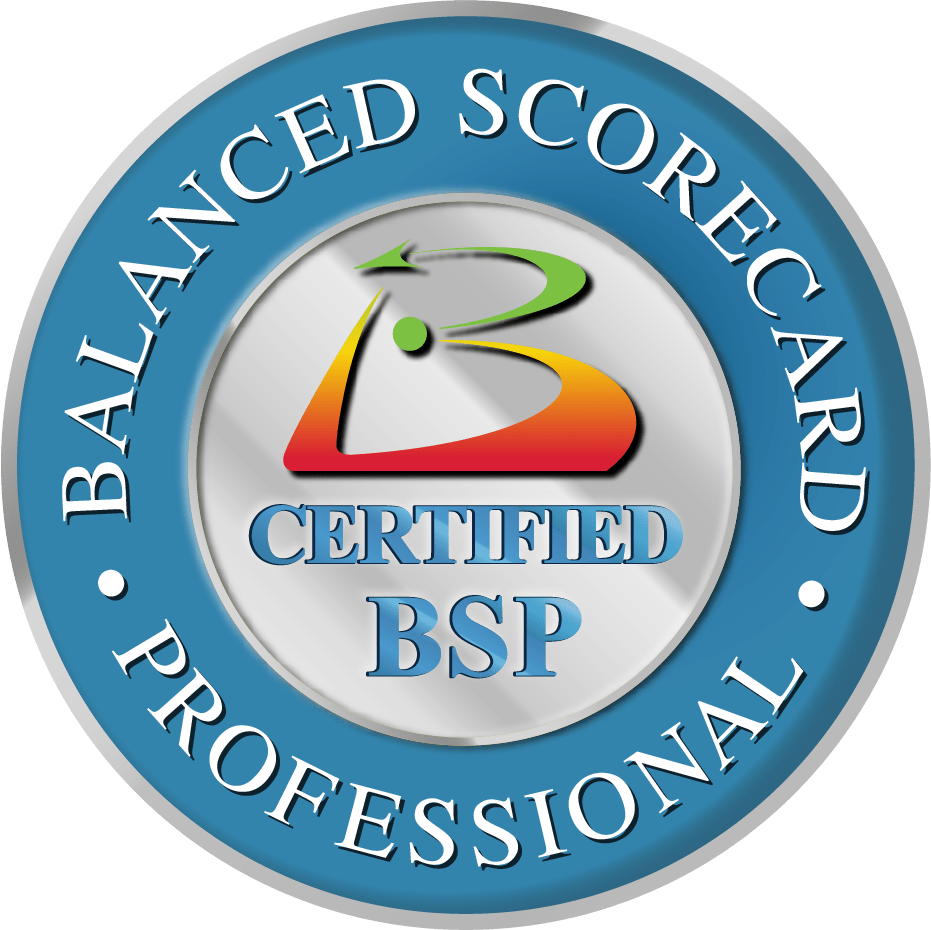
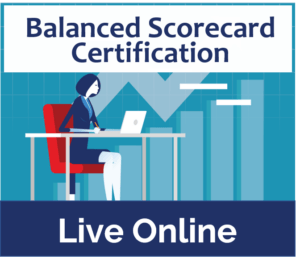
Free Articles
& White Papers

Nominate your organization for the Institute's Award for Excellence

Explore Our

DISCOUNTS
The Institute Way
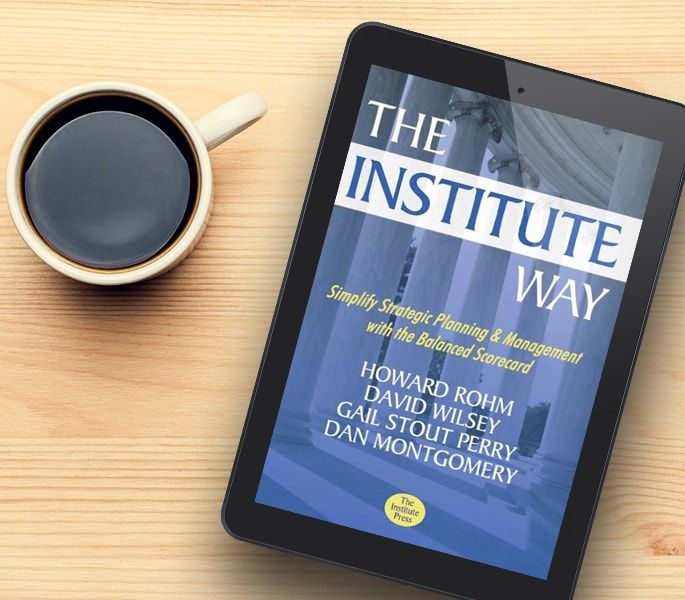
How to Learn More
To create a balanced scorecard, BSI recommends learning the Nine Steps to Success™. To learn more about this methodology, see our Professional Certification Programs, which are offered in association with the George Washington University Center for Excellence in Public Leadership, or contact us below with questions or inquiries about consulting services.
Why Choose a Balanced Scorecard Approach?
In today’s complex business environment, organizations struggle with translating strategy into action. A Balanced Scorecard provide a structured, proven framework to align organizational goals, measure performance effectively, and ensure long-term success. Business, government, and nonprofit organizations worldwide use the balanced scorecard system to:
- Clarify Vision & Strategy – Define clear, actionable strategic objectives.
- Align Teams & Resources – Ensure every department and individual contributes to strategic goals.
- Measure What Matters – Identify the right KPIs to track progress and drive continuous improvement.
- Improve Decision-Making – Use data-driven insights to optimize performance.
- Drive Accountability & Engagement – Foster a culture of performance and strategic focus.
Why Choose the Balanced Scorecard Institute?
With over two decades of experience, the Balanced Scorecard Institute (BSI) has empowered organizations worldwide to implement the BSC framework effectively. Our services include:
- Consulting Solutions: Tailored guidance to develop and execute strategic plans
- Training and Certification: Comprehensive programs to build internal expertise
- Software Tools: Innovative solutions to automate and monitor performance metrics
Our proven Nine Steps to Success™ methodology ensures a structured approach to strategy management, fostering alignment and accountability at all organizational levels.
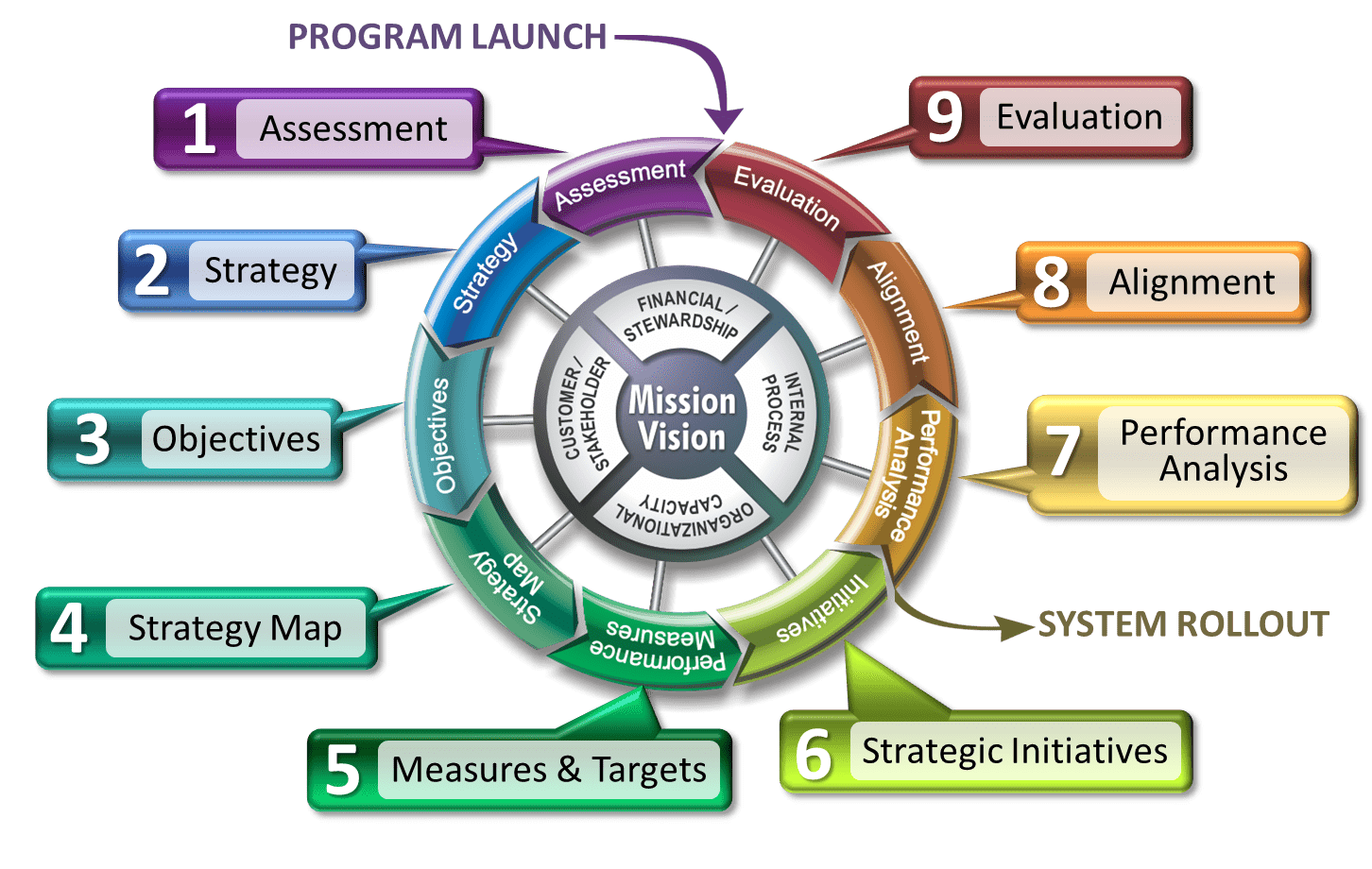
Contact us to find out how we can help you take your strategy to the next level!


